The Changing Face of Retail: A Case Study of Ocado
VerifiedAdded on 2022/01/05
|18
|4344
|21
Project
AI Summary
This business research project explores the evolving landscape of the UK retail sector, focusing on the challenges faced by traditional supermarkets like Tesco and Asda due to the emergence of new entrants, with Ocado as a specific case study. The project investigates the changing dynamics of the retail industry, including the impact of technology, changing consumer behaviors, and the rise of online shopping. It examines the factors contributing to the success of new entrants and the difficulties faced by established players. The research employs a positivism philosophy and a deductive approach, utilizing a descriptive research design to analyze the competitive pressures and strategic responses within the sector. The study aims to identify the challenges faced by major supermarkets and provide recommendations for overcoming these challenges in the face of disruptive competition.
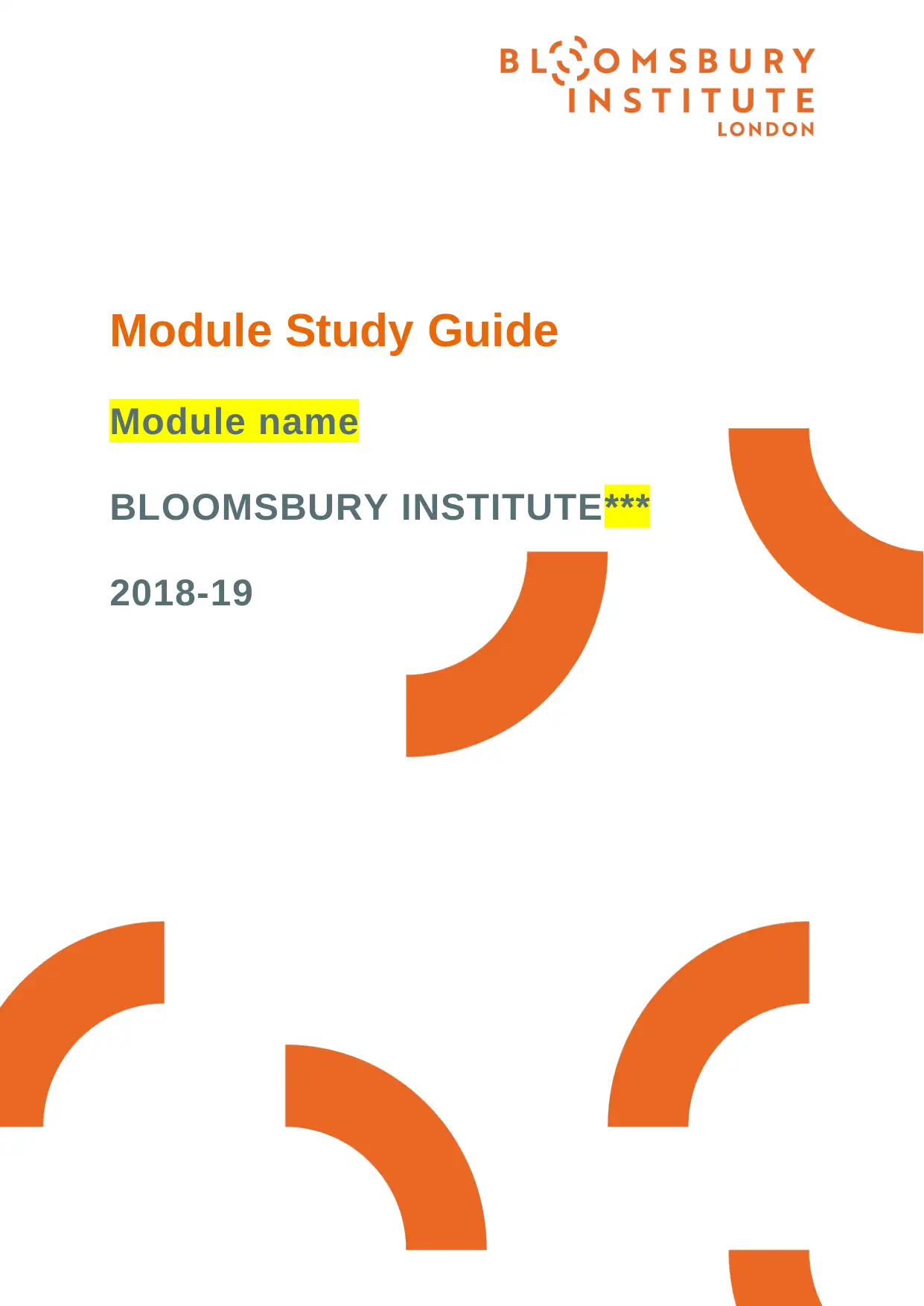
Module Study Guide
Module name
BLOOMSBURY INSTITUTE***
2018-19
Module name
BLOOMSBURY INSTITUTE***
2018-19
Paraphrase This Document
Need a fresh take? Get an instant paraphrase of this document with our AI Paraphraser
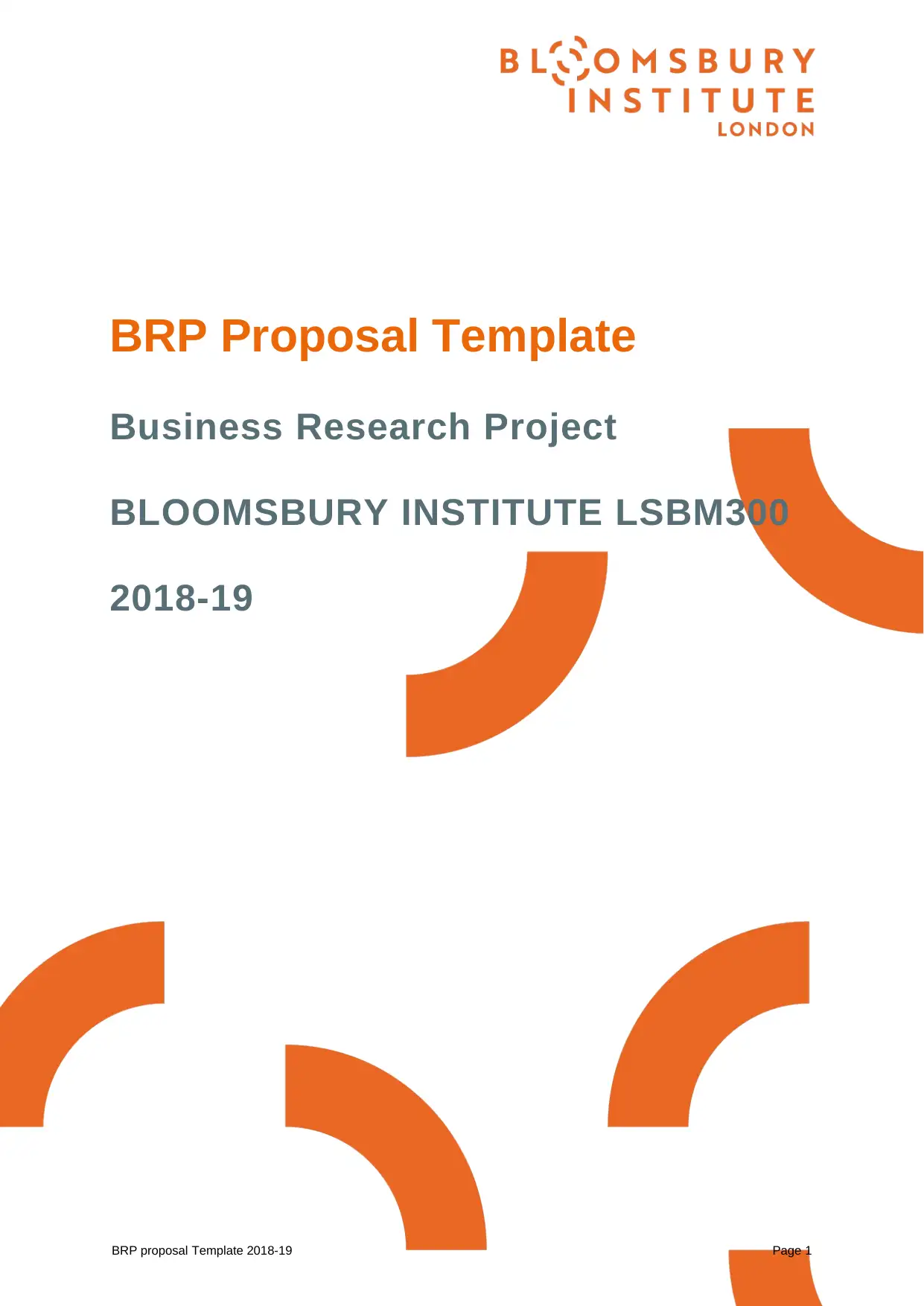
BRP proposal Template 2018-19 Page 1
BRP Proposal Template
Business Research Project
BLOOMSBURY INSTITUTE LSBM300
2018-19
BRP Proposal Template
Business Research Project
BLOOMSBURY INSTITUTE LSBM300
2018-19

Index
Instructions 2
1. The Proposal Template 3
2. Ethical Review Form 4
2.1 Ethical Review Form: Part 1 5
2.2 Ethical Review Form: Part 2 6
2.3 Ethical Review Form: Part 3 7
Appendix 1: Participant information sheet 9
Appendix 2: Participant consent form 10
BRP proposal Template 2018-19 Page 2
Instructions 2
1. The Proposal Template 3
2. Ethical Review Form 4
2.1 Ethical Review Form: Part 1 5
2.2 Ethical Review Form: Part 2 6
2.3 Ethical Review Form: Part 3 7
Appendix 1: Participant information sheet 9
Appendix 2: Participant consent form 10
BRP proposal Template 2018-19 Page 2
⊘ This is a preview!⊘
Do you want full access?
Subscribe today to unlock all pages.

Trusted by 1+ million students worldwide
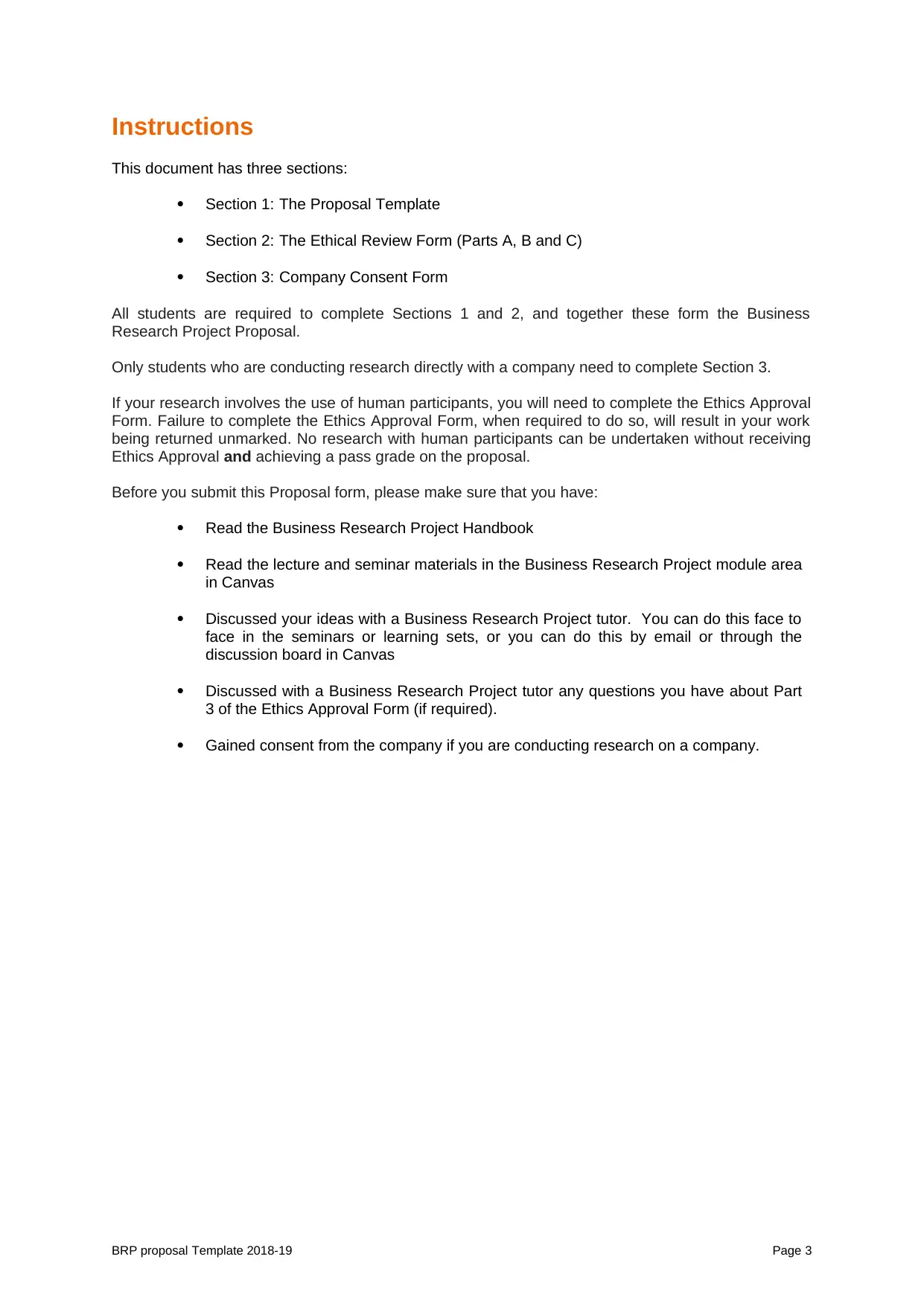
Instructions
This document has three sections:
Section 1: The Proposal Template
Section 2: The Ethical Review Form (Parts A, B and C)
Section 3: Company Consent Form
All students are required to complete Sections 1 and 2, and together these form the Business
Research Project Proposal.
Only students who are conducting research directly with a company need to complete Section 3.
If your research involves the use of human participants, you will need to complete the Ethics Approval
Form. Failure to complete the Ethics Approval Form, when required to do so, will result in your work
being returned unmarked. No research with human participants can be undertaken without receiving
Ethics Approval and achieving a pass grade on the proposal.
Before you submit this Proposal form, please make sure that you have:
Read the Business Research Project Handbook
Read the lecture and seminar materials in the Business Research Project module area
in Canvas
Discussed your ideas with a Business Research Project tutor. You can do this face to
face in the seminars or learning sets, or you can do this by email or through the
discussion board in Canvas
Discussed with a Business Research Project tutor any questions you have about Part
3 of the Ethics Approval Form (if required).
Gained consent from the company if you are conducting research on a company.
BRP proposal Template 2018-19 Page 3
This document has three sections:
Section 1: The Proposal Template
Section 2: The Ethical Review Form (Parts A, B and C)
Section 3: Company Consent Form
All students are required to complete Sections 1 and 2, and together these form the Business
Research Project Proposal.
Only students who are conducting research directly with a company need to complete Section 3.
If your research involves the use of human participants, you will need to complete the Ethics Approval
Form. Failure to complete the Ethics Approval Form, when required to do so, will result in your work
being returned unmarked. No research with human participants can be undertaken without receiving
Ethics Approval and achieving a pass grade on the proposal.
Before you submit this Proposal form, please make sure that you have:
Read the Business Research Project Handbook
Read the lecture and seminar materials in the Business Research Project module area
in Canvas
Discussed your ideas with a Business Research Project tutor. You can do this face to
face in the seminars or learning sets, or you can do this by email or through the
discussion board in Canvas
Discussed with a Business Research Project tutor any questions you have about Part
3 of the Ethics Approval Form (if required).
Gained consent from the company if you are conducting research on a company.
BRP proposal Template 2018-19 Page 3
Paraphrase This Document
Need a fresh take? Get an instant paraphrase of this document with our AI Paraphraser
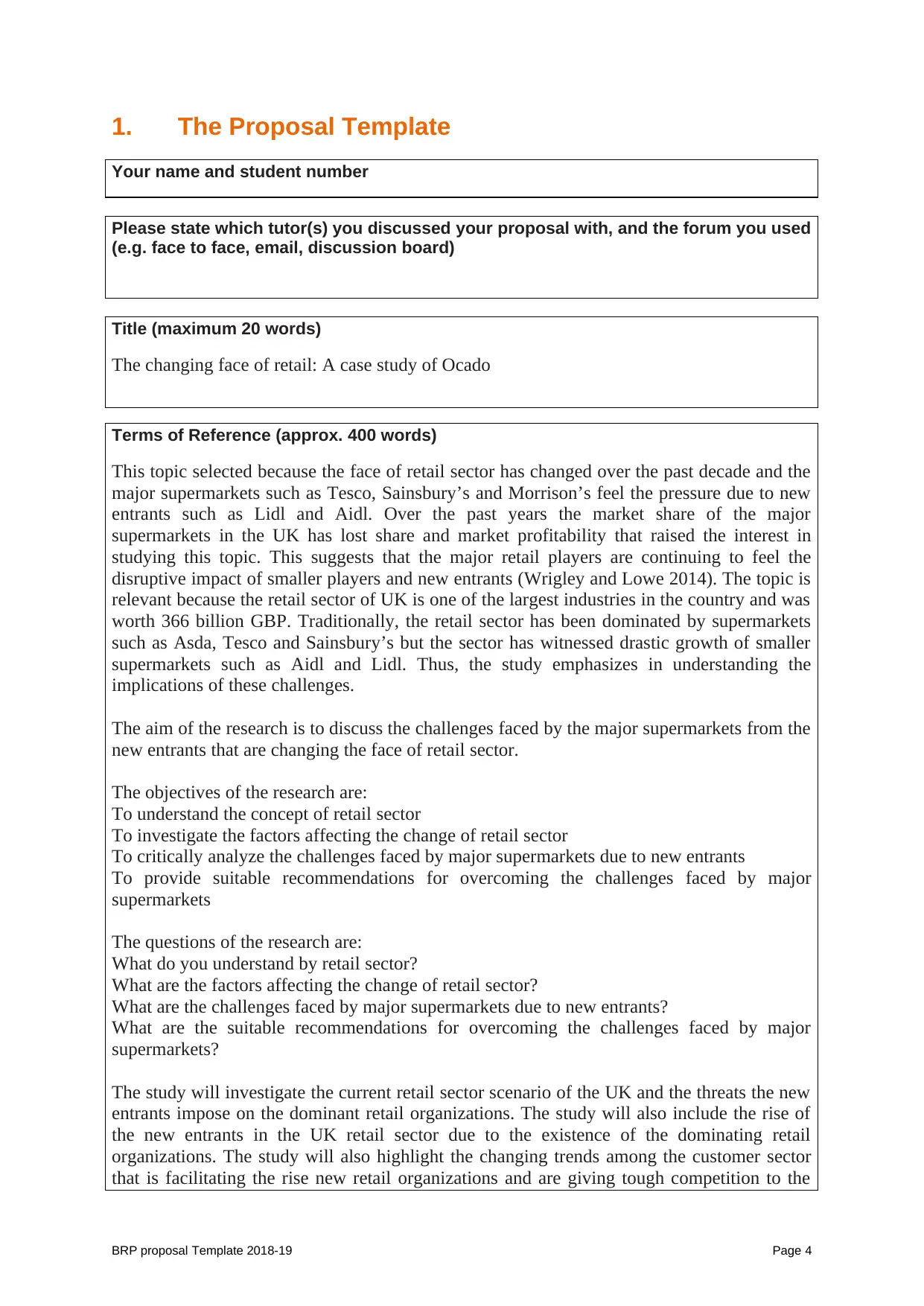
1. The Proposal Template
Your name and student number
Please state which tutor(s) you discussed your proposal with, and the forum you used
(e.g. face to face, email, discussion board)
Title (maximum 20 words)
The changing face of retail: A case study of Ocado
Terms of Reference (approx. 400 words)
This topic selected because the face of retail sector has changed over the past decade and the
major supermarkets such as Tesco, Sainsbury’s and Morrison’s feel the pressure due to new
entrants such as Lidl and Aidl. Over the past years the market share of the major
supermarkets in the UK has lost share and market profitability that raised the interest in
studying this topic. This suggests that the major retail players are continuing to feel the
disruptive impact of smaller players and new entrants (Wrigley and Lowe 2014). The topic is
relevant because the retail sector of UK is one of the largest industries in the country and was
worth 366 billion GBP. Traditionally, the retail sector has been dominated by supermarkets
such as Asda, Tesco and Sainsbury’s but the sector has witnessed drastic growth of smaller
supermarkets such as Aidl and Lidl. Thus, the study emphasizes in understanding the
implications of these challenges.
The aim of the research is to discuss the challenges faced by the major supermarkets from the
new entrants that are changing the face of retail sector.
The objectives of the research are:
To understand the concept of retail sector
To investigate the factors affecting the change of retail sector
To critically analyze the challenges faced by major supermarkets due to new entrants
To provide suitable recommendations for overcoming the challenges faced by major
supermarkets
The questions of the research are:
What do you understand by retail sector?
What are the factors affecting the change of retail sector?
What are the challenges faced by major supermarkets due to new entrants?
What are the suitable recommendations for overcoming the challenges faced by major
supermarkets?
The study will investigate the current retail sector scenario of the UK and the threats the new
entrants impose on the dominant retail organizations. The study will also include the rise of
the new entrants in the UK retail sector due to the existence of the dominating retail
organizations. The study will also highlight the changing trends among the customer sector
that is facilitating the rise new retail organizations and are giving tough competition to the
BRP proposal Template 2018-19 Page 4
Your name and student number
Please state which tutor(s) you discussed your proposal with, and the forum you used
(e.g. face to face, email, discussion board)
Title (maximum 20 words)
The changing face of retail: A case study of Ocado
Terms of Reference (approx. 400 words)
This topic selected because the face of retail sector has changed over the past decade and the
major supermarkets such as Tesco, Sainsbury’s and Morrison’s feel the pressure due to new
entrants such as Lidl and Aidl. Over the past years the market share of the major
supermarkets in the UK has lost share and market profitability that raised the interest in
studying this topic. This suggests that the major retail players are continuing to feel the
disruptive impact of smaller players and new entrants (Wrigley and Lowe 2014). The topic is
relevant because the retail sector of UK is one of the largest industries in the country and was
worth 366 billion GBP. Traditionally, the retail sector has been dominated by supermarkets
such as Asda, Tesco and Sainsbury’s but the sector has witnessed drastic growth of smaller
supermarkets such as Aidl and Lidl. Thus, the study emphasizes in understanding the
implications of these challenges.
The aim of the research is to discuss the challenges faced by the major supermarkets from the
new entrants that are changing the face of retail sector.
The objectives of the research are:
To understand the concept of retail sector
To investigate the factors affecting the change of retail sector
To critically analyze the challenges faced by major supermarkets due to new entrants
To provide suitable recommendations for overcoming the challenges faced by major
supermarkets
The questions of the research are:
What do you understand by retail sector?
What are the factors affecting the change of retail sector?
What are the challenges faced by major supermarkets due to new entrants?
What are the suitable recommendations for overcoming the challenges faced by major
supermarkets?
The study will investigate the current retail sector scenario of the UK and the threats the new
entrants impose on the dominant retail organizations. The study will also include the rise of
the new entrants in the UK retail sector due to the existence of the dominating retail
organizations. The study will also highlight the changing trends among the customer sector
that is facilitating the rise new retail organizations and are giving tough competition to the
BRP proposal Template 2018-19 Page 4
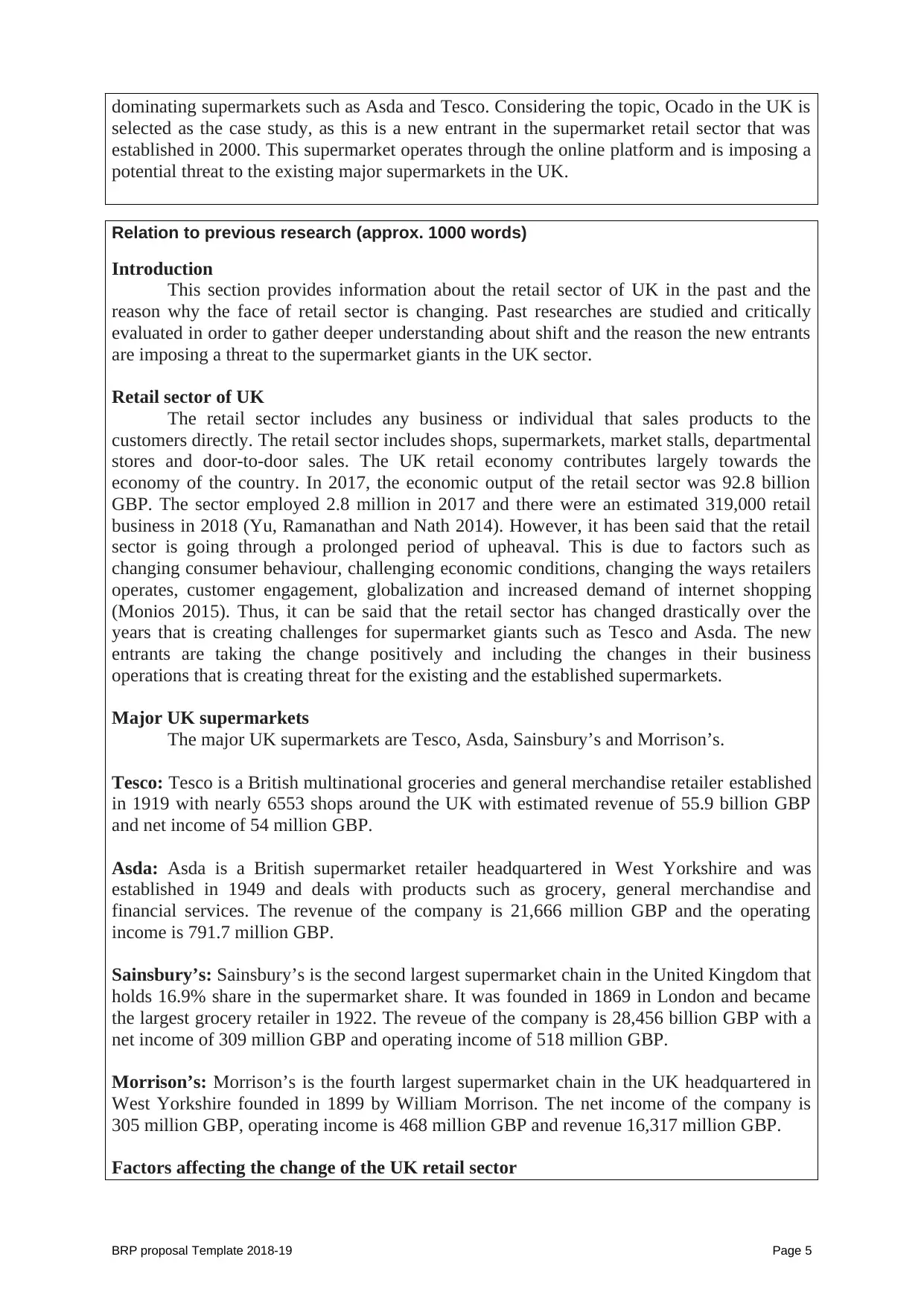
dominating supermarkets such as Asda and Tesco. Considering the topic, Ocado in the UK is
selected as the case study, as this is a new entrant in the supermarket retail sector that was
established in 2000. This supermarket operates through the online platform and is imposing a
potential threat to the existing major supermarkets in the UK.
Relation to previous research (approx. 1000 words)
Introduction
This section provides information about the retail sector of UK in the past and the
reason why the face of retail sector is changing. Past researches are studied and critically
evaluated in order to gather deeper understanding about shift and the reason the new entrants
are imposing a threat to the supermarket giants in the UK sector.
Retail sector of UK
The retail sector includes any business or individual that sales products to the
customers directly. The retail sector includes shops, supermarkets, market stalls, departmental
stores and door-to-door sales. The UK retail economy contributes largely towards the
economy of the country. In 2017, the economic output of the retail sector was 92.8 billion
GBP. The sector employed 2.8 million in 2017 and there were an estimated 319,000 retail
business in 2018 (Yu, Ramanathan and Nath 2014). However, it has been said that the retail
sector is going through a prolonged period of upheaval. This is due to factors such as
changing consumer behaviour, challenging economic conditions, changing the ways retailers
operates, customer engagement, globalization and increased demand of internet shopping
(Monios 2015). Thus, it can be said that the retail sector has changed drastically over the
years that is creating challenges for supermarket giants such as Tesco and Asda. The new
entrants are taking the change positively and including the changes in their business
operations that is creating threat for the existing and the established supermarkets.
Major UK supermarkets
The major UK supermarkets are Tesco, Asda, Sainsbury’s and Morrison’s.
Tesco: Tesco is a British multinational groceries and general merchandise retailer established
in 1919 with nearly 6553 shops around the UK with estimated revenue of 55.9 billion GBP
and net income of 54 million GBP.
Asda: Asda is a British supermarket retailer headquartered in West Yorkshire and was
established in 1949 and deals with products such as grocery, general merchandise and
financial services. The revenue of the company is 21,666 million GBP and the operating
income is 791.7 million GBP.
Sainsbury’s: Sainsbury’s is the second largest supermarket chain in the United Kingdom that
holds 16.9% share in the supermarket share. It was founded in 1869 in London and became
the largest grocery retailer in 1922. The reveue of the company is 28,456 billion GBP with a
net income of 309 million GBP and operating income of 518 million GBP.
Morrison’s: Morrison’s is the fourth largest supermarket chain in the UK headquartered in
West Yorkshire founded in 1899 by William Morrison. The net income of the company is
305 million GBP, operating income is 468 million GBP and revenue 16,317 million GBP.
Factors affecting the change of the UK retail sector
BRP proposal Template 2018-19 Page 5
selected as the case study, as this is a new entrant in the supermarket retail sector that was
established in 2000. This supermarket operates through the online platform and is imposing a
potential threat to the existing major supermarkets in the UK.
Relation to previous research (approx. 1000 words)
Introduction
This section provides information about the retail sector of UK in the past and the
reason why the face of retail sector is changing. Past researches are studied and critically
evaluated in order to gather deeper understanding about shift and the reason the new entrants
are imposing a threat to the supermarket giants in the UK sector.
Retail sector of UK
The retail sector includes any business or individual that sales products to the
customers directly. The retail sector includes shops, supermarkets, market stalls, departmental
stores and door-to-door sales. The UK retail economy contributes largely towards the
economy of the country. In 2017, the economic output of the retail sector was 92.8 billion
GBP. The sector employed 2.8 million in 2017 and there were an estimated 319,000 retail
business in 2018 (Yu, Ramanathan and Nath 2014). However, it has been said that the retail
sector is going through a prolonged period of upheaval. This is due to factors such as
changing consumer behaviour, challenging economic conditions, changing the ways retailers
operates, customer engagement, globalization and increased demand of internet shopping
(Monios 2015). Thus, it can be said that the retail sector has changed drastically over the
years that is creating challenges for supermarket giants such as Tesco and Asda. The new
entrants are taking the change positively and including the changes in their business
operations that is creating threat for the existing and the established supermarkets.
Major UK supermarkets
The major UK supermarkets are Tesco, Asda, Sainsbury’s and Morrison’s.
Tesco: Tesco is a British multinational groceries and general merchandise retailer established
in 1919 with nearly 6553 shops around the UK with estimated revenue of 55.9 billion GBP
and net income of 54 million GBP.
Asda: Asda is a British supermarket retailer headquartered in West Yorkshire and was
established in 1949 and deals with products such as grocery, general merchandise and
financial services. The revenue of the company is 21,666 million GBP and the operating
income is 791.7 million GBP.
Sainsbury’s: Sainsbury’s is the second largest supermarket chain in the United Kingdom that
holds 16.9% share in the supermarket share. It was founded in 1869 in London and became
the largest grocery retailer in 1922. The reveue of the company is 28,456 billion GBP with a
net income of 309 million GBP and operating income of 518 million GBP.
Morrison’s: Morrison’s is the fourth largest supermarket chain in the UK headquartered in
West Yorkshire founded in 1899 by William Morrison. The net income of the company is
305 million GBP, operating income is 468 million GBP and revenue 16,317 million GBP.
Factors affecting the change of the UK retail sector
BRP proposal Template 2018-19 Page 5
⊘ This is a preview!⊘
Do you want full access?
Subscribe today to unlock all pages.

Trusted by 1+ million students worldwide
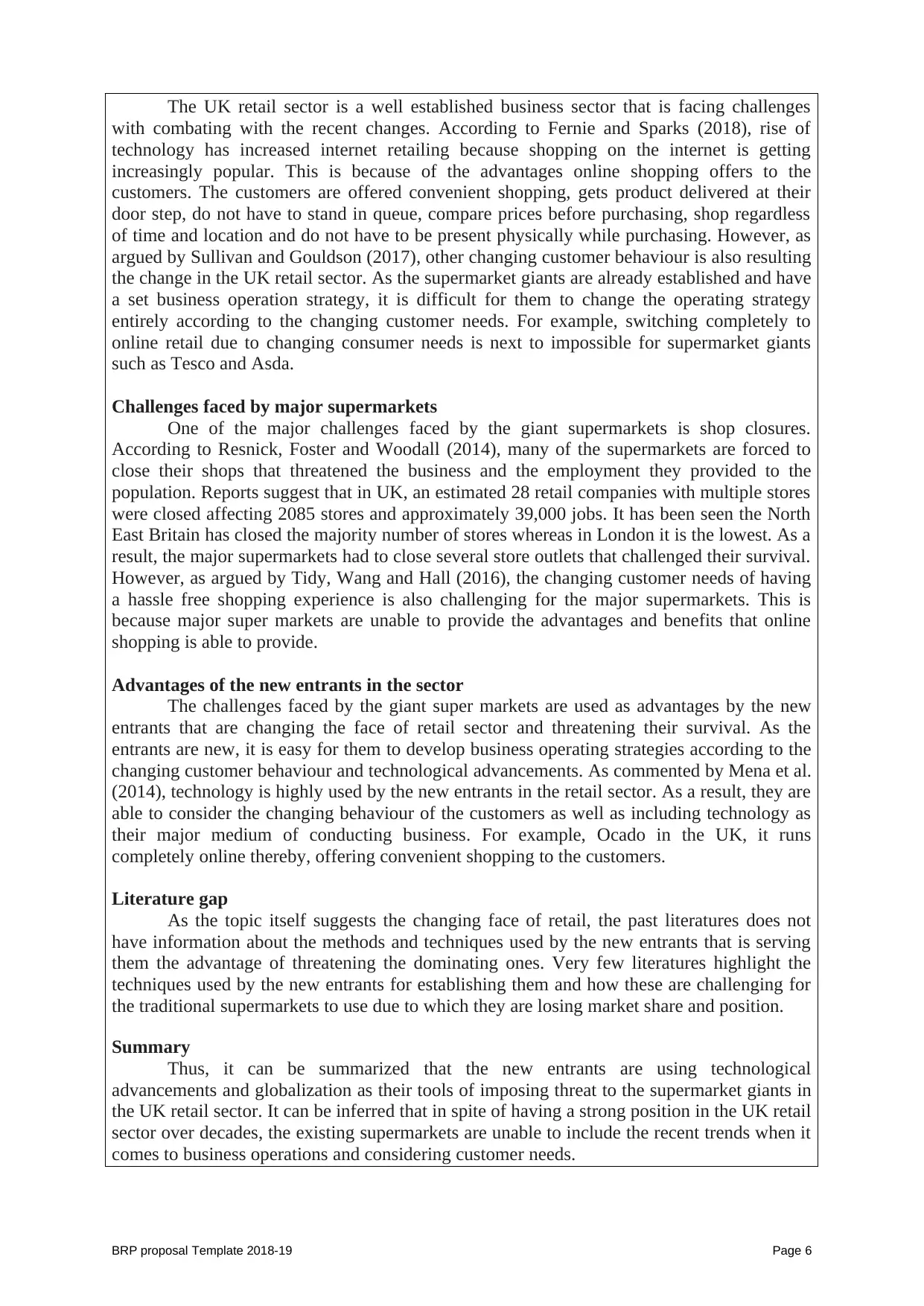
The UK retail sector is a well established business sector that is facing challenges
with combating with the recent changes. According to Fernie and Sparks (2018), rise of
technology has increased internet retailing because shopping on the internet is getting
increasingly popular. This is because of the advantages online shopping offers to the
customers. The customers are offered convenient shopping, gets product delivered at their
door step, do not have to stand in queue, compare prices before purchasing, shop regardless
of time and location and do not have to be present physically while purchasing. However, as
argued by Sullivan and Gouldson (2017), other changing customer behaviour is also resulting
the change in the UK retail sector. As the supermarket giants are already established and have
a set business operation strategy, it is difficult for them to change the operating strategy
entirely according to the changing customer needs. For example, switching completely to
online retail due to changing consumer needs is next to impossible for supermarket giants
such as Tesco and Asda.
Challenges faced by major supermarkets
One of the major challenges faced by the giant supermarkets is shop closures.
According to Resnick, Foster and Woodall (2014), many of the supermarkets are forced to
close their shops that threatened the business and the employment they provided to the
population. Reports suggest that in UK, an estimated 28 retail companies with multiple stores
were closed affecting 2085 stores and approximately 39,000 jobs. It has been seen the North
East Britain has closed the majority number of stores whereas in London it is the lowest. As a
result, the major supermarkets had to close several store outlets that challenged their survival.
However, as argued by Tidy, Wang and Hall (2016), the changing customer needs of having
a hassle free shopping experience is also challenging for the major supermarkets. This is
because major super markets are unable to provide the advantages and benefits that online
shopping is able to provide.
Advantages of the new entrants in the sector
The challenges faced by the giant super markets are used as advantages by the new
entrants that are changing the face of retail sector and threatening their survival. As the
entrants are new, it is easy for them to develop business operating strategies according to the
changing customer behaviour and technological advancements. As commented by Mena et al.
(2014), technology is highly used by the new entrants in the retail sector. As a result, they are
able to consider the changing behaviour of the customers as well as including technology as
their major medium of conducting business. For example, Ocado in the UK, it runs
completely online thereby, offering convenient shopping to the customers.
Literature gap
As the topic itself suggests the changing face of retail, the past literatures does not
have information about the methods and techniques used by the new entrants that is serving
them the advantage of threatening the dominating ones. Very few literatures highlight the
techniques used by the new entrants for establishing them and how these are challenging for
the traditional supermarkets to use due to which they are losing market share and position.
Summary
Thus, it can be summarized that the new entrants are using technological
advancements and globalization as their tools of imposing threat to the supermarket giants in
the UK retail sector. It can be inferred that in spite of having a strong position in the UK retail
sector over decades, the existing supermarkets are unable to include the recent trends when it
comes to business operations and considering customer needs.
BRP proposal Template 2018-19 Page 6
with combating with the recent changes. According to Fernie and Sparks (2018), rise of
technology has increased internet retailing because shopping on the internet is getting
increasingly popular. This is because of the advantages online shopping offers to the
customers. The customers are offered convenient shopping, gets product delivered at their
door step, do not have to stand in queue, compare prices before purchasing, shop regardless
of time and location and do not have to be present physically while purchasing. However, as
argued by Sullivan and Gouldson (2017), other changing customer behaviour is also resulting
the change in the UK retail sector. As the supermarket giants are already established and have
a set business operation strategy, it is difficult for them to change the operating strategy
entirely according to the changing customer needs. For example, switching completely to
online retail due to changing consumer needs is next to impossible for supermarket giants
such as Tesco and Asda.
Challenges faced by major supermarkets
One of the major challenges faced by the giant supermarkets is shop closures.
According to Resnick, Foster and Woodall (2014), many of the supermarkets are forced to
close their shops that threatened the business and the employment they provided to the
population. Reports suggest that in UK, an estimated 28 retail companies with multiple stores
were closed affecting 2085 stores and approximately 39,000 jobs. It has been seen the North
East Britain has closed the majority number of stores whereas in London it is the lowest. As a
result, the major supermarkets had to close several store outlets that challenged their survival.
However, as argued by Tidy, Wang and Hall (2016), the changing customer needs of having
a hassle free shopping experience is also challenging for the major supermarkets. This is
because major super markets are unable to provide the advantages and benefits that online
shopping is able to provide.
Advantages of the new entrants in the sector
The challenges faced by the giant super markets are used as advantages by the new
entrants that are changing the face of retail sector and threatening their survival. As the
entrants are new, it is easy for them to develop business operating strategies according to the
changing customer behaviour and technological advancements. As commented by Mena et al.
(2014), technology is highly used by the new entrants in the retail sector. As a result, they are
able to consider the changing behaviour of the customers as well as including technology as
their major medium of conducting business. For example, Ocado in the UK, it runs
completely online thereby, offering convenient shopping to the customers.
Literature gap
As the topic itself suggests the changing face of retail, the past literatures does not
have information about the methods and techniques used by the new entrants that is serving
them the advantage of threatening the dominating ones. Very few literatures highlight the
techniques used by the new entrants for establishing them and how these are challenging for
the traditional supermarkets to use due to which they are losing market share and position.
Summary
Thus, it can be summarized that the new entrants are using technological
advancements and globalization as their tools of imposing threat to the supermarket giants in
the UK retail sector. It can be inferred that in spite of having a strong position in the UK retail
sector over decades, the existing supermarkets are unable to include the recent trends when it
comes to business operations and considering customer needs.
BRP proposal Template 2018-19 Page 6
Paraphrase This Document
Need a fresh take? Get an instant paraphrase of this document with our AI Paraphraser
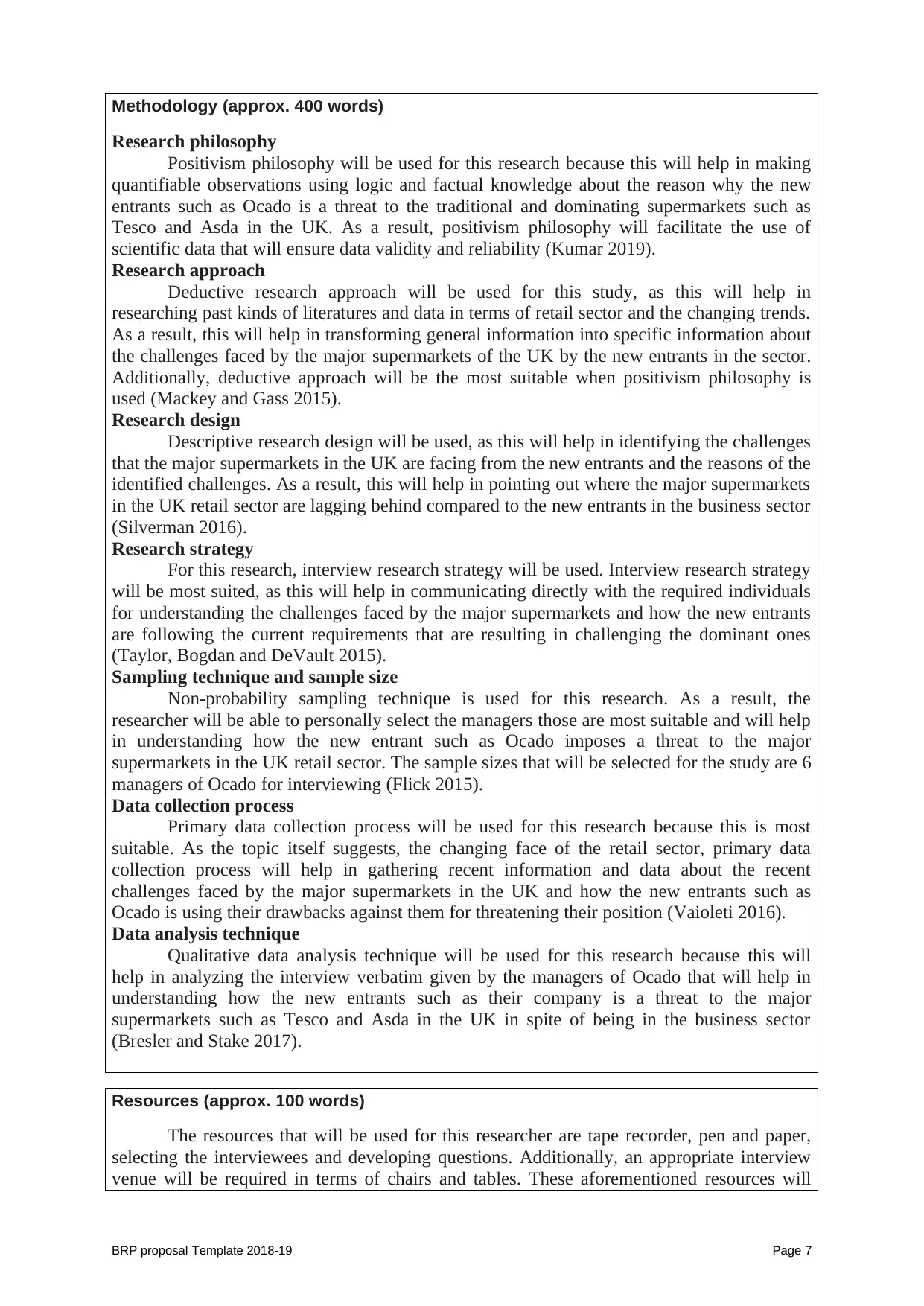
Methodology (approx. 400 words)
Research philosophy
Positivism philosophy will be used for this research because this will help in making
quantifiable observations using logic and factual knowledge about the reason why the new
entrants such as Ocado is a threat to the traditional and dominating supermarkets such as
Tesco and Asda in the UK. As a result, positivism philosophy will facilitate the use of
scientific data that will ensure data validity and reliability (Kumar 2019).
Research approach
Deductive research approach will be used for this study, as this will help in
researching past kinds of literatures and data in terms of retail sector and the changing trends.
As a result, this will help in transforming general information into specific information about
the challenges faced by the major supermarkets of the UK by the new entrants in the sector.
Additionally, deductive approach will be the most suitable when positivism philosophy is
used (Mackey and Gass 2015).
Research design
Descriptive research design will be used, as this will help in identifying the challenges
that the major supermarkets in the UK are facing from the new entrants and the reasons of the
identified challenges. As a result, this will help in pointing out where the major supermarkets
in the UK retail sector are lagging behind compared to the new entrants in the business sector
(Silverman 2016).
Research strategy
For this research, interview research strategy will be used. Interview research strategy
will be most suited, as this will help in communicating directly with the required individuals
for understanding the challenges faced by the major supermarkets and how the new entrants
are following the current requirements that are resulting in challenging the dominant ones
(Taylor, Bogdan and DeVault 2015).
Sampling technique and sample size
Non-probability sampling technique is used for this research. As a result, the
researcher will be able to personally select the managers those are most suitable and will help
in understanding how the new entrant such as Ocado imposes a threat to the major
supermarkets in the UK retail sector. The sample sizes that will be selected for the study are 6
managers of Ocado for interviewing (Flick 2015).
Data collection process
Primary data collection process will be used for this research because this is most
suitable. As the topic itself suggests, the changing face of the retail sector, primary data
collection process will help in gathering recent information and data about the recent
challenges faced by the major supermarkets in the UK and how the new entrants such as
Ocado is using their drawbacks against them for threatening their position (Vaioleti 2016).
Data analysis technique
Qualitative data analysis technique will be used for this research because this will
help in analyzing the interview verbatim given by the managers of Ocado that will help in
understanding how the new entrants such as their company is a threat to the major
supermarkets such as Tesco and Asda in the UK in spite of being in the business sector
(Bresler and Stake 2017).
Resources (approx. 100 words)
The resources that will be used for this researcher are tape recorder, pen and paper,
selecting the interviewees and developing questions. Additionally, an appropriate interview
venue will be required in terms of chairs and tables. These aforementioned resources will
BRP proposal Template 2018-19 Page 7
Research philosophy
Positivism philosophy will be used for this research because this will help in making
quantifiable observations using logic and factual knowledge about the reason why the new
entrants such as Ocado is a threat to the traditional and dominating supermarkets such as
Tesco and Asda in the UK. As a result, positivism philosophy will facilitate the use of
scientific data that will ensure data validity and reliability (Kumar 2019).
Research approach
Deductive research approach will be used for this study, as this will help in
researching past kinds of literatures and data in terms of retail sector and the changing trends.
As a result, this will help in transforming general information into specific information about
the challenges faced by the major supermarkets of the UK by the new entrants in the sector.
Additionally, deductive approach will be the most suitable when positivism philosophy is
used (Mackey and Gass 2015).
Research design
Descriptive research design will be used, as this will help in identifying the challenges
that the major supermarkets in the UK are facing from the new entrants and the reasons of the
identified challenges. As a result, this will help in pointing out where the major supermarkets
in the UK retail sector are lagging behind compared to the new entrants in the business sector
(Silverman 2016).
Research strategy
For this research, interview research strategy will be used. Interview research strategy
will be most suited, as this will help in communicating directly with the required individuals
for understanding the challenges faced by the major supermarkets and how the new entrants
are following the current requirements that are resulting in challenging the dominant ones
(Taylor, Bogdan and DeVault 2015).
Sampling technique and sample size
Non-probability sampling technique is used for this research. As a result, the
researcher will be able to personally select the managers those are most suitable and will help
in understanding how the new entrant such as Ocado imposes a threat to the major
supermarkets in the UK retail sector. The sample sizes that will be selected for the study are 6
managers of Ocado for interviewing (Flick 2015).
Data collection process
Primary data collection process will be used for this research because this is most
suitable. As the topic itself suggests, the changing face of the retail sector, primary data
collection process will help in gathering recent information and data about the recent
challenges faced by the major supermarkets in the UK and how the new entrants such as
Ocado is using their drawbacks against them for threatening their position (Vaioleti 2016).
Data analysis technique
Qualitative data analysis technique will be used for this research because this will
help in analyzing the interview verbatim given by the managers of Ocado that will help in
understanding how the new entrants such as their company is a threat to the major
supermarkets such as Tesco and Asda in the UK in spite of being in the business sector
(Bresler and Stake 2017).
Resources (approx. 100 words)
The resources that will be used for this researcher are tape recorder, pen and paper,
selecting the interviewees and developing questions. Additionally, an appropriate interview
venue will be required in terms of chairs and tables. These aforementioned resources will
BRP proposal Template 2018-19 Page 7
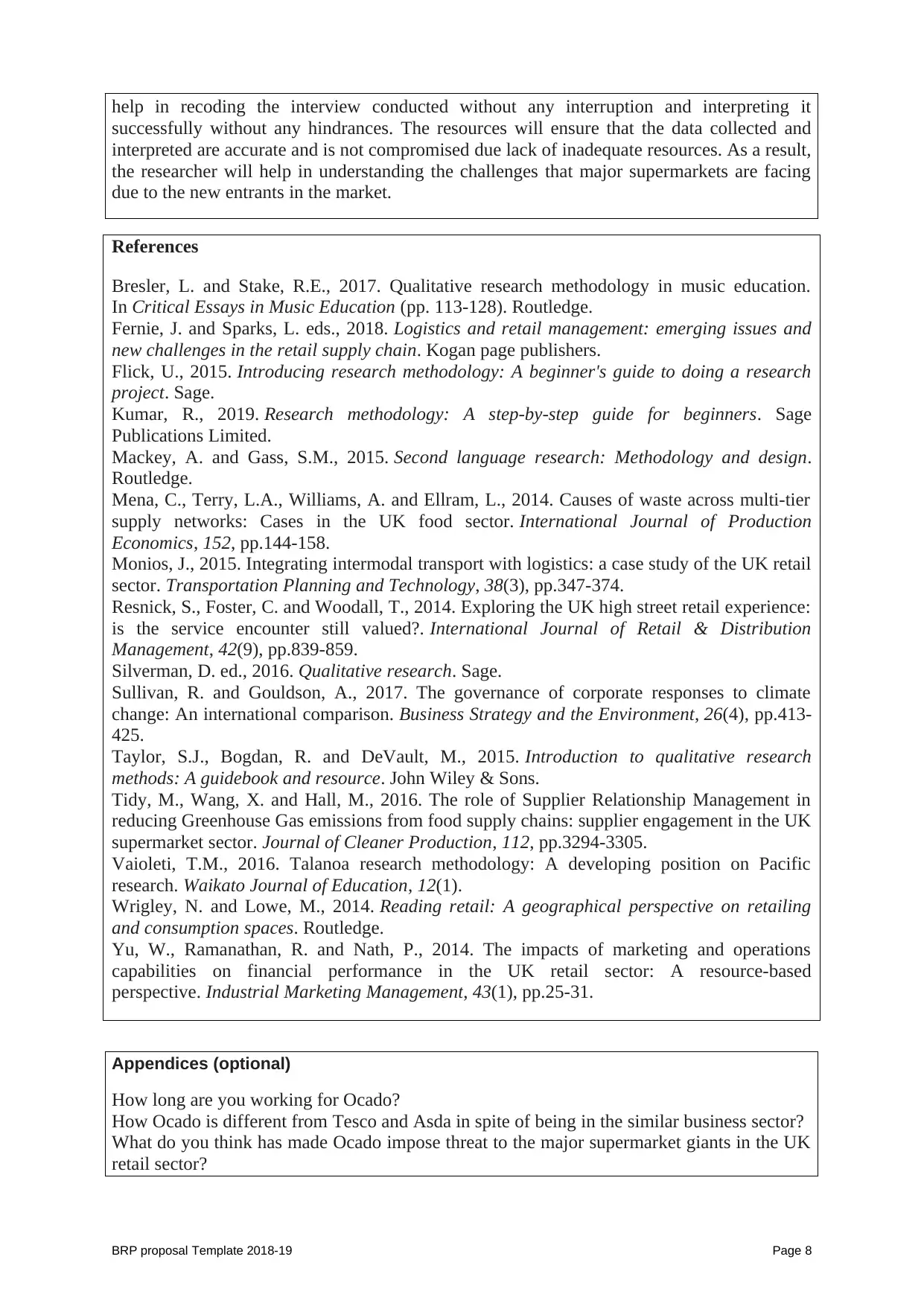
help in recoding the interview conducted without any interruption and interpreting it
successfully without any hindrances. The resources will ensure that the data collected and
interpreted are accurate and is not compromised due lack of inadequate resources. As a result,
the researcher will help in understanding the challenges that major supermarkets are facing
due to the new entrants in the market.
References
Bresler, L. and Stake, R.E., 2017. Qualitative research methodology in music education.
In Critical Essays in Music Education (pp. 113-128). Routledge.
Fernie, J. and Sparks, L. eds., 2018. Logistics and retail management: emerging issues and
new challenges in the retail supply chain. Kogan page publishers.
Flick, U., 2015. Introducing research methodology: A beginner's guide to doing a research
project. Sage.
Kumar, R., 2019. Research methodology: A step-by-step guide for beginners. Sage
Publications Limited.
Mackey, A. and Gass, S.M., 2015. Second language research: Methodology and design.
Routledge.
Mena, C., Terry, L.A., Williams, A. and Ellram, L., 2014. Causes of waste across multi-tier
supply networks: Cases in the UK food sector. International Journal of Production
Economics, 152, pp.144-158.
Monios, J., 2015. Integrating intermodal transport with logistics: a case study of the UK retail
sector. Transportation Planning and Technology, 38(3), pp.347-374.
Resnick, S., Foster, C. and Woodall, T., 2014. Exploring the UK high street retail experience:
is the service encounter still valued?. International Journal of Retail & Distribution
Management, 42(9), pp.839-859.
Silverman, D. ed., 2016. Qualitative research. Sage.
Sullivan, R. and Gouldson, A., 2017. The governance of corporate responses to climate
change: An international comparison. Business Strategy and the Environment, 26(4), pp.413-
425.
Taylor, S.J., Bogdan, R. and DeVault, M., 2015. Introduction to qualitative research
methods: A guidebook and resource. John Wiley & Sons.
Tidy, M., Wang, X. and Hall, M., 2016. The role of Supplier Relationship Management in
reducing Greenhouse Gas emissions from food supply chains: supplier engagement in the UK
supermarket sector. Journal of Cleaner Production, 112, pp.3294-3305.
Vaioleti, T.M., 2016. Talanoa research methodology: A developing position on Pacific
research. Waikato Journal of Education, 12(1).
Wrigley, N. and Lowe, M., 2014. Reading retail: A geographical perspective on retailing
and consumption spaces. Routledge.
Yu, W., Ramanathan, R. and Nath, P., 2014. The impacts of marketing and operations
capabilities on financial performance in the UK retail sector: A resource-based
perspective. Industrial Marketing Management, 43(1), pp.25-31.
Appendices (optional)
How long are you working for Ocado?
How Ocado is different from Tesco and Asda in spite of being in the similar business sector?
What do you think has made Ocado impose threat to the major supermarket giants in the UK
retail sector?
BRP proposal Template 2018-19 Page 8
successfully without any hindrances. The resources will ensure that the data collected and
interpreted are accurate and is not compromised due lack of inadequate resources. As a result,
the researcher will help in understanding the challenges that major supermarkets are facing
due to the new entrants in the market.
References
Bresler, L. and Stake, R.E., 2017. Qualitative research methodology in music education.
In Critical Essays in Music Education (pp. 113-128). Routledge.
Fernie, J. and Sparks, L. eds., 2018. Logistics and retail management: emerging issues and
new challenges in the retail supply chain. Kogan page publishers.
Flick, U., 2015. Introducing research methodology: A beginner's guide to doing a research
project. Sage.
Kumar, R., 2019. Research methodology: A step-by-step guide for beginners. Sage
Publications Limited.
Mackey, A. and Gass, S.M., 2015. Second language research: Methodology and design.
Routledge.
Mena, C., Terry, L.A., Williams, A. and Ellram, L., 2014. Causes of waste across multi-tier
supply networks: Cases in the UK food sector. International Journal of Production
Economics, 152, pp.144-158.
Monios, J., 2015. Integrating intermodal transport with logistics: a case study of the UK retail
sector. Transportation Planning and Technology, 38(3), pp.347-374.
Resnick, S., Foster, C. and Woodall, T., 2014. Exploring the UK high street retail experience:
is the service encounter still valued?. International Journal of Retail & Distribution
Management, 42(9), pp.839-859.
Silverman, D. ed., 2016. Qualitative research. Sage.
Sullivan, R. and Gouldson, A., 2017. The governance of corporate responses to climate
change: An international comparison. Business Strategy and the Environment, 26(4), pp.413-
425.
Taylor, S.J., Bogdan, R. and DeVault, M., 2015. Introduction to qualitative research
methods: A guidebook and resource. John Wiley & Sons.
Tidy, M., Wang, X. and Hall, M., 2016. The role of Supplier Relationship Management in
reducing Greenhouse Gas emissions from food supply chains: supplier engagement in the UK
supermarket sector. Journal of Cleaner Production, 112, pp.3294-3305.
Vaioleti, T.M., 2016. Talanoa research methodology: A developing position on Pacific
research. Waikato Journal of Education, 12(1).
Wrigley, N. and Lowe, M., 2014. Reading retail: A geographical perspective on retailing
and consumption spaces. Routledge.
Yu, W., Ramanathan, R. and Nath, P., 2014. The impacts of marketing and operations
capabilities on financial performance in the UK retail sector: A resource-based
perspective. Industrial Marketing Management, 43(1), pp.25-31.
Appendices (optional)
How long are you working for Ocado?
How Ocado is different from Tesco and Asda in spite of being in the similar business sector?
What do you think has made Ocado impose threat to the major supermarket giants in the UK
retail sector?
BRP proposal Template 2018-19 Page 8
⊘ This is a preview!⊘
Do you want full access?
Subscribe today to unlock all pages.

Trusted by 1+ million students worldwide

Do you think Ocado has been able to consider the changing needs of the customers in the
retail sector?
What do you think are the major challenges that supermarket giants such as Tesco and Asda
are facing in the UK?
Is the changing face of retail beneficial for new entrants?
BRP proposal Template 2018-19 Page 9
retail sector?
What do you think are the major challenges that supermarket giants such as Tesco and Asda
are facing in the UK?
Is the changing face of retail beneficial for new entrants?
BRP proposal Template 2018-19 Page 9
Paraphrase This Document
Need a fresh take? Get an instant paraphrase of this document with our AI Paraphraser
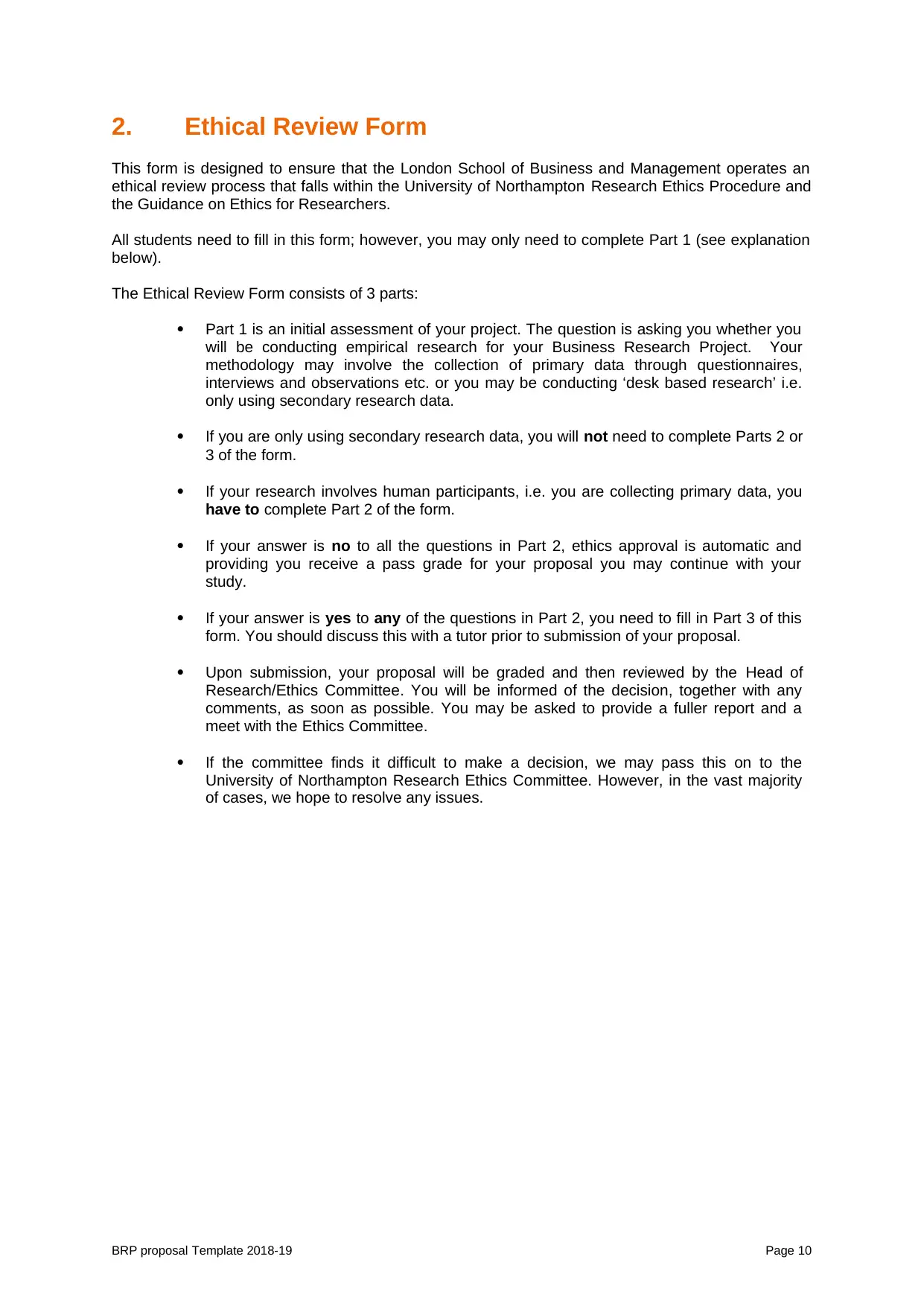
2. Ethical Review Form
This form is designed to ensure that the London School of Business and Management operates an
ethical review process that falls within the University of Northampton Research Ethics Procedure and
the Guidance on Ethics for Researchers.
All students need to fill in this form; however, you may only need to complete Part 1 (see explanation
below).
The Ethical Review Form consists of 3 parts:
Part 1 is an initial assessment of your project. The question is asking you whether you
will be conducting empirical research for your Business Research Project. Your
methodology may involve the collection of primary data through questionnaires,
interviews and observations etc. or you may be conducting ‘desk based research’ i.e.
only using secondary research data.
If you are only using secondary research data, you will not need to complete Parts 2 or
3 of the form.
If your research involves human participants, i.e. you are collecting primary data, you
have to complete Part 2 of the form.
If your answer is no to all the questions in Part 2, ethics approval is automatic and
providing you receive a pass grade for your proposal you may continue with your
study.
If your answer is yes to any of the questions in Part 2, you need to fill in Part 3 of this
form. You should discuss this with a tutor prior to submission of your proposal.
Upon submission, your proposal will be graded and then reviewed by the Head of
Research/Ethics Committee. You will be informed of the decision, together with any
comments, as soon as possible. You may be asked to provide a fuller report and a
meet with the Ethics Committee.
If the committee finds it difficult to make a decision, we may pass this on to the
University of Northampton Research Ethics Committee. However, in the vast majority
of cases, we hope to resolve any issues.
BRP proposal Template 2018-19 Page 10
This form is designed to ensure that the London School of Business and Management operates an
ethical review process that falls within the University of Northampton Research Ethics Procedure and
the Guidance on Ethics for Researchers.
All students need to fill in this form; however, you may only need to complete Part 1 (see explanation
below).
The Ethical Review Form consists of 3 parts:
Part 1 is an initial assessment of your project. The question is asking you whether you
will be conducting empirical research for your Business Research Project. Your
methodology may involve the collection of primary data through questionnaires,
interviews and observations etc. or you may be conducting ‘desk based research’ i.e.
only using secondary research data.
If you are only using secondary research data, you will not need to complete Parts 2 or
3 of the form.
If your research involves human participants, i.e. you are collecting primary data, you
have to complete Part 2 of the form.
If your answer is no to all the questions in Part 2, ethics approval is automatic and
providing you receive a pass grade for your proposal you may continue with your
study.
If your answer is yes to any of the questions in Part 2, you need to fill in Part 3 of this
form. You should discuss this with a tutor prior to submission of your proposal.
Upon submission, your proposal will be graded and then reviewed by the Head of
Research/Ethics Committee. You will be informed of the decision, together with any
comments, as soon as possible. You may be asked to provide a fuller report and a
meet with the Ethics Committee.
If the committee finds it difficult to make a decision, we may pass this on to the
University of Northampton Research Ethics Committee. However, in the vast majority
of cases, we hope to resolve any issues.
BRP proposal Template 2018-19 Page 10
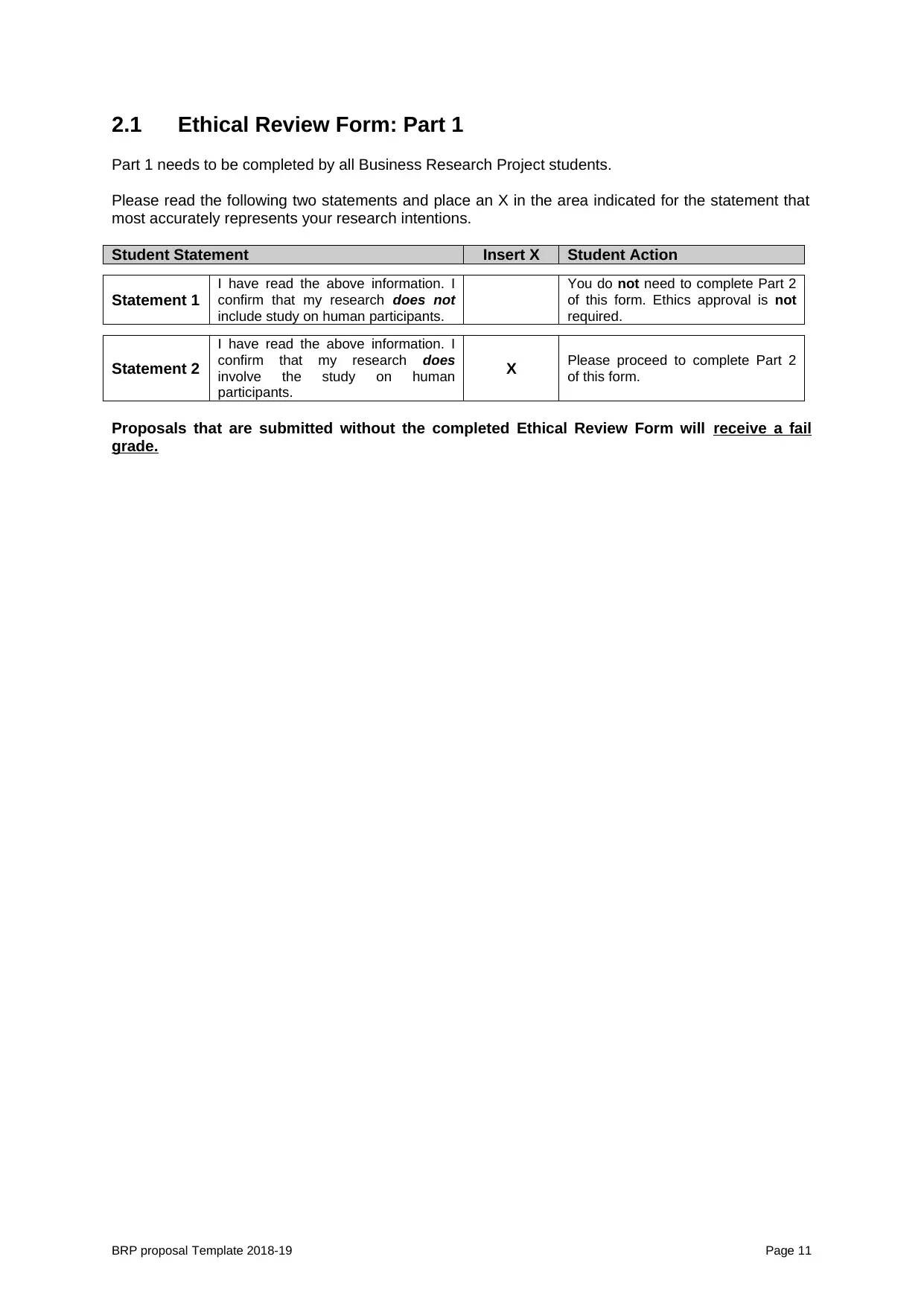
2.1 Ethical Review Form: Part 1
Part 1 needs to be completed by all Business Research Project students.
Please read the following two statements and place an X in the area indicated for the statement that
most accurately represents your research intentions.
Student Statement Insert X Student Action
Statement 1
I have read the above information. I
confirm that my research does not
include study on human participants.
You do not need to complete Part 2
of this form. Ethics approval is not
required.
Statement 2
I have read the above information. I
confirm that my research does
involve the study on human
participants.
X Please proceed to complete Part 2
of this form.
Proposals that are submitted without the completed Ethical Review Form will receive a fail
grade.
BRP proposal Template 2018-19 Page 11
Part 1 needs to be completed by all Business Research Project students.
Please read the following two statements and place an X in the area indicated for the statement that
most accurately represents your research intentions.
Student Statement Insert X Student Action
Statement 1
I have read the above information. I
confirm that my research does not
include study on human participants.
You do not need to complete Part 2
of this form. Ethics approval is not
required.
Statement 2
I have read the above information. I
confirm that my research does
involve the study on human
participants.
X Please proceed to complete Part 2
of this form.
Proposals that are submitted without the completed Ethical Review Form will receive a fail
grade.
BRP proposal Template 2018-19 Page 11
⊘ This is a preview!⊘
Do you want full access?
Subscribe today to unlock all pages.

Trusted by 1+ million students worldwide
1 out of 18
Related Documents
Your All-in-One AI-Powered Toolkit for Academic Success.
+13062052269
info@desklib.com
Available 24*7 on WhatsApp / Email
![[object Object]](/_next/static/media/star-bottom.7253800d.svg)
Unlock your academic potential
Copyright © 2020–2025 A2Z Services. All Rights Reserved. Developed and managed by ZUCOL.




